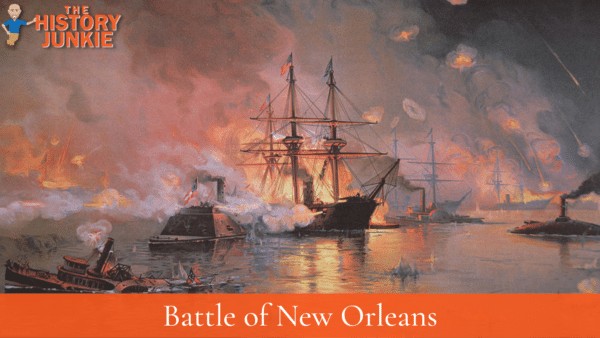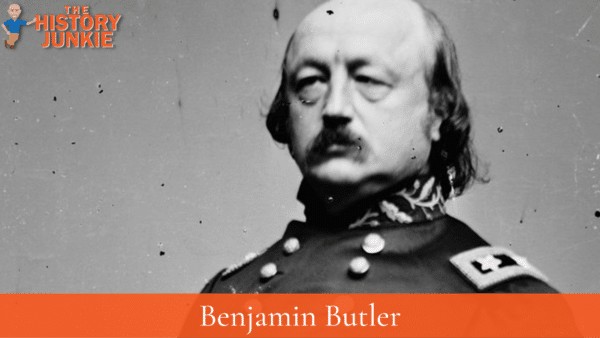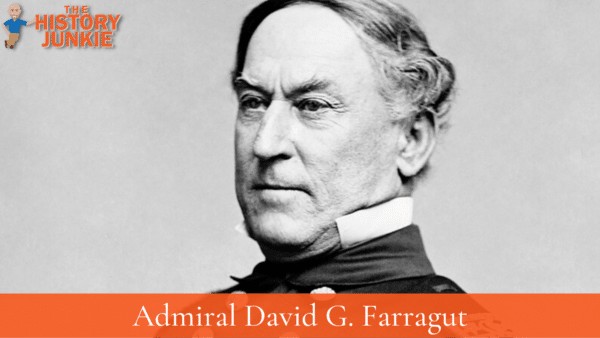During the winter of 1861-1862, the national government decided to retake Mobile, New Orleans, Baton Rouge, and Galveston and gain control of the lower Mississippi and Texas. The Battle of New Orleans would be of tremendous importance as it was when Andrew Jackson defeated the British at New Orleans in the War of 1812.

The Department of the Gulf was created, and General Benjamin F. Butler was placed in command. It was proposed to send a competent land and naval force to capture New Orleans first.
Jump to:
Prelude
General George McClellan did not think the plan to capture New Orleans was feasible. He believed that it would take 50,000 men, and he was unwilling to spare any men from his army of more than 200,000 men that were stationed around Washington.
However, President Abraham Lincoln approved of the project, and Secretary of War Edwin Stanton offered General Butler a promotion to lieutenant general if he could capture New Orleans.

Butler called for troops, and New England responded with enthusiasm. In addition to the thousands of troops that were already serving in the Army of the Potomac, New England sent 1,400 troops to Butler's command.
On February 25, 1862, General Butler sailed from Fort Monroe with his wife, his staff, and 1,400 New England troops. The voyage was long and difficult due to storms and delays. It took thirty days for them to land on Ship Island, off the coast of Mississippi.
The island was dreary and unfinished, and the Confederates had taken possession of it and the fort. They had made the fort strong and available for defense during their occupation of it for about four months.
The Confederates built Fort Twiggs, a formidable stronghold with eleven bomb-proof casemates, a magazine, barracks, and twenty heavy Dahlgren guns.
But when word spread that a powerful Union fleet was approaching, the Confederates fled, burning the barracks and taking their cannons with them. The next day, a small Union force from the gunboat Massachusetts landed and took possession of the fort.
The Union forces strengthened Fort Massachusetts by building two more casemates, adding Dahlgren and rifled cannon, and piling around its outer walls tiers of sandbags six feet in depth. They renamed the fort after their vessel, the USS Massachusetts.
When General Butler arrived, there was no house on the island for him or his wife to stay in. With much difficulty, a decent place of shelter was prepared for them.

General Phelps was also at Ship Island with New England troops, as were Commodore David Farragut with a naval force and Commodore D. D. Porter with a fleet of bomb vessels.
Forts Jackson and St. Philip were located 60 miles below New Orleans. The Confederates believed that these forts, along with some fortifications above and obstructions in the river below, made the Mississippi River impassable to vessels.
There were 10,000 troops in New Orleans under the command of General Mansfield Lovell.
A New Orleans newspaper boasted, "Our only fear is that the Northern invaders might not appear. We have made such extensive preparations to receive them that it would be vexing if their invincible armada escapes the fate we have in store for it."
The Battle
On April 28, 1862, the fleets of Commodore David Farragut and Commodore D. D. Porter entered the Mississippi River. Farragut was in command of the naval forces, and General Benjamin Butler, with about 9,000 troops, was at the Southwest Pass.
The fleets comprised 47 armed vessels, and these, with the transports, went up the river with Porter's mortar boats leading.
When they approached the forts, their hulls were covered in mud, and their rigging was covered with branches of trees.
This camouflage allowed them to take a position near the forts without being detected.
The Mississippi River was overflowing its banks, and a boom and other obstructions near Fort Jackson had been swept away by the flood. On April 18, a battle began between Fort Jackson and Porter's mortar boats.
The gunboats supported the mortar boats, but they were unable to inflict significant damage on the forts.
On the night of April 23, the fleet attempted to run past the forts, with the mortar boats providing covering fire.
The difficult passage of the forts began at 2:00 AM. The night was pitch black, and in the darkness, a tremendous battle was waged.
The Union naval force was met by a Confederate one. In that struggle, the Union forces were victorious.
Surrender
While the battle was raging near the forts, General Butler landed his troops in small boats and passed through narrow and shallow bayous in the rear of Fort St. Philip.
The frightened Confederate garrison surrendered to General Butler without a fight. They said they had been forced to join the army and didn't want to fight anymore.
After the forts surrendered and the Confederate gunboats were defeated, Admiral Farragut met up with his fleet at Quarantine. Then, with nine ships, he sailed up to New Orleans.
Aftermath
The people of New Orleans were terrified. They had heard about the disasters that had happened downstream.
Drums were beating, soldiers were running around, and cotton was being carried to the levee to be burned. Four million dollars had been taken from the banks, and citizens with millions of dollars in property had fled the city.
When Admiral Farragut approached New Orleans on April 23, General Lovell and his troops fled. The Confederates set fire to the cotton on the levee, destroying 15,000 bales of cotton, a dozen large ships, and as many fine steamers. Unfinished gunboats and other large vessels were also destroyed.
The citizens of New Orleans were held under duress by Farragut's guns until the arrival of General Butler on May 1. Butler landed with his troops, took formal possession of the defenseless city, and made his headquarters at the St. Charles Hotel.
The loss at the Battle of New Orleans was a terrible blow to the Confederacy during the Civil War. The city was a major economic and strategic center, and its capture gave the Union a significant advantage in the war.
It also secured control over the Mississippi River, which continued the Anaconda Plan put forth by Winfield Scott.
